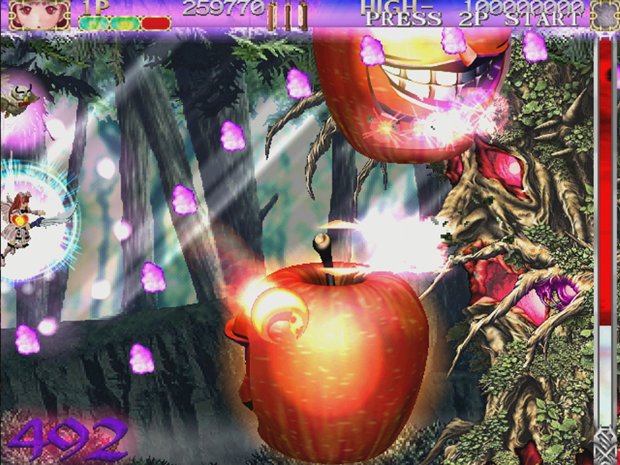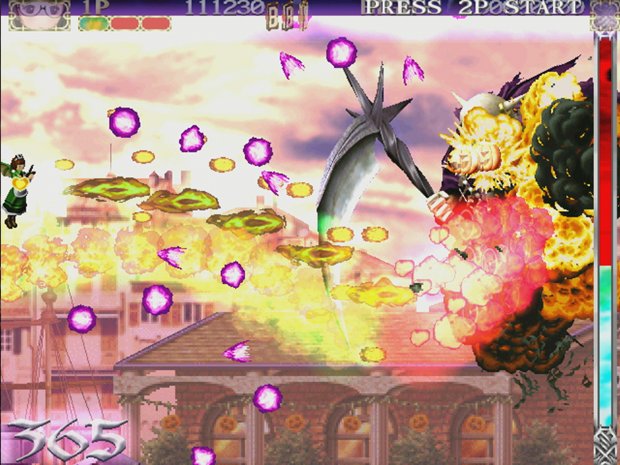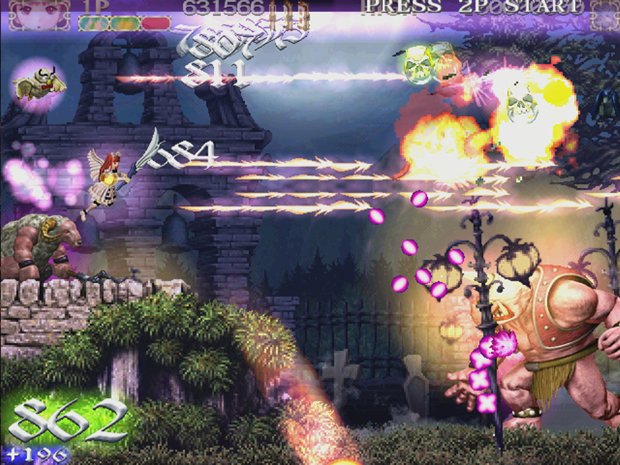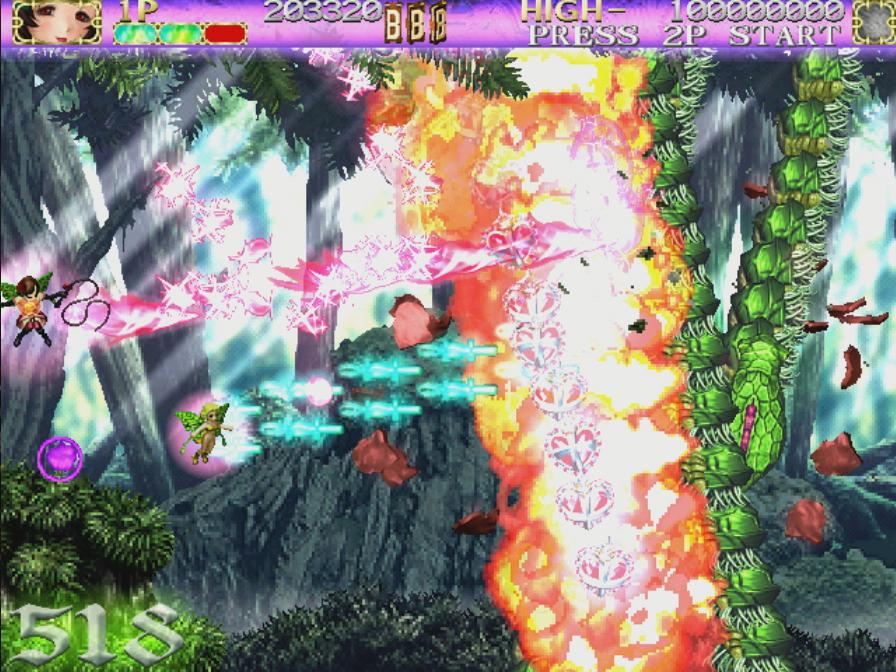GamesRadar+ Verdict
Pros
- +
Satisfying shooting mechanics
- +
Risk-reward nuances add excitement
- +
Multiple modes add replay value
Cons
- -
Becomes incredibly difficult...
- -
... yet unlimited continues reduce tension
- -
The price is ridiculous
Why you can trust GamesRadar+
Deathsmiles is a lovely little bullet-hell shoot-‘em-up, originally from the arcade, and now getting a retail release. It stars four young witches and their familiars, with a weirdly shoehorned-in story of no consequence, although the important part is the setting: essentially a scrolling shooter version of Ghosts ‘N Goblins. Instead of guiding a spaceship against swarms of UFOs and aliens, you guide a cute, magically floating girl against monsters and demons. The strictly 2D artwork is lavishly detailed and always surprising with its weird monster designs. Like Mary, the giant angry cow, for instance.

Above: Or giant, grinning apples spewed from a frowning, haunted mega-tree
Now, if you’re not familiar with bullet-hell shooters, know that their trademark is, as the name implies, screens literally filled with bullets until there are mere pixels of room for you to navigate safely. First off, don’t let that discourage you if you’re a casual shooter fan. Deathsmiles uses an infinite continue mechanic, so no matter how much you die, you can make it through the whole game. While this may rile the shooter hardcore, and we did find that it took some of the tension out of the challenge, those looking for perfecting their skills won’t be disappointed because there are scores to be chased, and using continues whittles away the precious high score.
The core shooting mechanics of Deathsmiles at first seem almost too simplistic, but they deliver extremely satisfying action and incredibly tense moments. There are no powerups to speak of, but don’t worry about that. First consider how you shoot: one button fires to your right; the other to your left. Enemies come from all sides, but the game helpfully warns you when enemies are about to arrive from behind you. Tapping a fire button produces weak shots, but they also typically follow a pattern that makes it easy to hit multiple enemies. You can fire continuously by holding down one button, which narrows your weapon’s focus while increasing its power, but this slows you down. We actually ended up almost always continuously firing because planning out a flight path means you don’t have to react swiftly to incoming bullets, and the slower movement makes it much easier to traverse the true bullet-hell boss fights. An expert would probably learn the perfect balance between tap-firing and hold-firing.

Above: Hmm, themany times we played through this forest level, we never once noticed the pretty slanting sunlight filtering through the tree. Too busy dodging bullets
Holding down both fire buttons creates a small radius around your witch where she will auto-target enemies, so it’s useful when you’re surrounded or have enemies directly above or below. That’s basically it for the firing, but then you have to consider the item collection. See, most enemies drop goodies when they die. These items superficially are just bonus points, but there’s more to it: they add up to a counter in the corner, and when that counter reaches a certain point (dependent on game mode), you can unleash uber firepower by hitting both fire buttons. Now, not only do you blast out ridiculous beams of death, but enemies also drop greater bonus items. As long as you can keep collecting the items, your draining super-weapon will be able to keep going, so it’s an exciting “how long can I stay super-powered” mechanic. The item counter is also a resource: In order to keep the auto-targeting attack from being the catch-all attack, it drains your item counter.
Of course, there are nuances to the item collecting itself: items don’t float in space where you kill an enemy. Instead, they lob out in a shallow arc and hit the ground. By catching them in the air, you’ll grab more points, so you have to get real close to enemies to maximize your score. This, of course, makes gameplay even more tense as you get right up in giant, energy-ball spraying ogres’ faces.

Above: There's a Grim Reaper inside all those explosions, in case his huge scythe didn't give him away
The main game is quite short – you can beat the final boss within half an hour of starting the game. Luckily, there are many ways to extend replayability. First, you have four witches to select from, and each has a different firing spread and a differently behaving familiar (plus a fifth witch when playing Mega Black Label Mode). After that, you also have four difficulty ranks that you can apply to any given level. The awesome thing is, upping the difficulty doesn’t just make enemy bullets faster and more numerous. Enemies will actually have entirely new attack patterns, replete with new animations. It’s great fun to encounter a boss and wonder what crazy ultra-attack he’ll throw at you now.
The game also offers several modes of play, and each mixes up gameplay enough to warrant yet more replays. In addition to the original arcade version, there’s the 1.1 version, which tweaks a few things, but most significantly, adds twin-stick control. Now, you can control your familiar with the right stick. It can be distracting when you’re trying to dodge 300 bullets on screen, but turns out to add a new layer of play as you can attack enemies from two angles at once and really rack up the points. Mega Black Label Mode allows you to play asthe fifth witch and turn the difficulty up to the fourth notch, which is naturally bullet-madness (there’s a reason the difficulty ranks from 1-3, and then straight to 999). Finally, there is two-player available, both offline and over Xbox Live. It makes the game almost too chaotic, but if you and a friend love scrolling shooters, it’s another worthwhile addition.

Above: A crucial art-design element is the depiction of enemy bullets. No matter how full of craziness the screen gets, you can always easily see the purple enemy bullets
All this enthusiasm leads us to the sad reality of the game’s release. This would have been a glorious XBLA title at $10-$15, but Deathsmiles comes as a boxed copy and asks the uncanny price of $50. Sure, the game has replay value, but after a few playthroughs, only the ultra dedicated score chasers will have reason to keep going. Even then, it doesn’t feel like $50 worth of score chasing. We really wanted to give this game an 8, because it is really, really fun and imaginative. But the cash-burn is just too much. We’re betting the price will drop quickly, and in the mean time, it’s absolutely worth a rental.
Jul 15, 2010
More info
| Description | We really wanted to give this game an 8, because it is really, really fun and imaginative. But the cash-burn is just too much. We’re betting the price will drop quickly, and in the mean time, it’s absolutely worth a rental. |
| Platform | "Xbox 360" |
| US censor rating | "Teen" |
| UK censor rating | "" |
| Release date | 1 January 1970 (US), 1 January 1970 (UK) |




